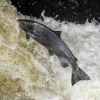Articles
Fine sediments, often due to run-off from the land, can clog the surface and sub-surface spaces in gravel beds used by spawning fish to lay their eggs and by aquatic insects. Without an adequate flow of oxygenated water, the eggs and insects die. Heather Haynes, Susithra Lakshmanan, Anne-Marie Ockelford, Elisa Vignaga and William Holmes tells us about this in “The emerging use of magnetic resonance imaging to study river bed dynamics”. They have studied the infiltration of various sediments into model gravel beds both outside and flowing through a MRI instrument! They conclude that MRI “provides an exciting opportunity to unravel a plethora of processes relevant to wider environmental science”.
Peter A. Rinck
European Magnetic Resonance Forum (EMRF) Foundation, WTC, BP 255, F-06905 Sophia Antipolis Cedex, France
In 1946, two scientists in the United States, independently of each other, described a physicochemical phenomenon that was based upon the magnetic properties of certain nuclei in the periodic system. This was “nuclear magnetic resonance”, for short “NMR”. The two scientists, Felix Bloch and Edward M. Purcell were awarded the Nobel Prize in Physics in 1952.



